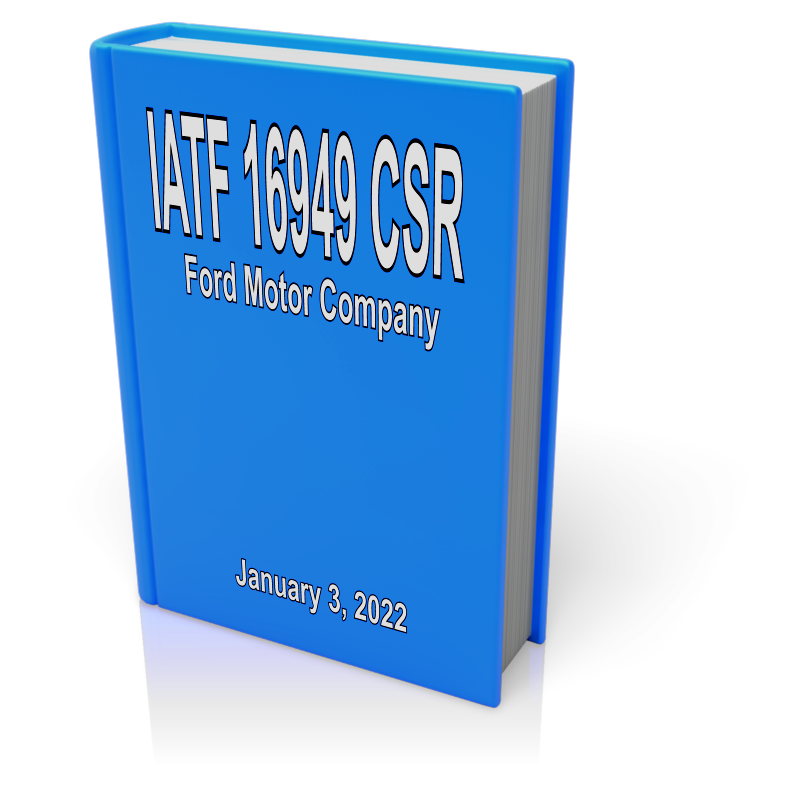
Ford’s 2022 IATF 16949 Customer Specific FMEA Requirements
– What They Mean To You
On December 7, 2021 Ford updated their IATF 1949 Customer Specific Requirements (“CSR”). The effective date for the change was January 3, 2022. The primary CSR changes dealt with FMEAs.
Ford FMEA Handbook Selected as Preferred FMEA Standard
The new Ford CSR identifies the Ford FMEA Handbook as the preferred FMEA standard that must be complied with (see FSP Document Library (https://fsp.portal.covisint.com/web/portal/document_library). Although not preferred, if a company uses the AIAG & VDA FMEA Handbook, the format will be accepted.
Most Significant CSR Change
Many companies will find that that the most significant new Ford CSR change is the requirement that companies use software designed to meet the multiple FMEA requirements identified rather than Excel. It has been estimated that as many as 75 percent of automotive suppliers use Excel-based approaches create their FMEAs and associated documents. If this estimate is accurate, a considerable number of automotive suppliers will be affected.
Ford does not specify a particular software that must be purchased but does outline the functionality that the software must support. Following are four of the key features the must support.
Key Feature One: Foundation FMEA Support
Per the new Ford CSR, “Foundation FMEAs are also known as corporate, generic, baseline, core, master, or best practice FMEAs and contain knowledge of the organization from prior developments and problem-solving activities for each process type (e.g, stamping, riveting, injection molding, etc.).” The goal of using Foundation FMEAs is to capture and reuse important lessons learned.
The Foundation FMEAs are not intended to be replacement for the Part FMEA. Instead, the Foundation FMEA is intended to be a starting point for the Part FMEA. The proper use of Foundation FMEAs results in both improved Part FMEAs and reduced development time.
Key Feature Two: Foundation FMEA and Part FMEA Linkage
The Part and Foundation FMEAs must be living documents that are always aligned.
Key Feature Three: Foundation FMEA and Part FMEA Linkage with Other Process Control Documents
Foundation FMEA and Part FMEA must be aligned to the control plans and work instructions/visual aids.
Key Feature Four: Reverse FMEA Implementation Support
There are no published standards for the performance of a “Reverse FMEA” (aka “Reverse Process FMEA”). The new Ford CSR states the Reverse FMEA “involves design and process engineers working with operators and attempting to make bad parts, beat the error proofing and find new failure modes, causes, and develop controls”. The goal of the Reverse FMEA is to uncover possible problems or opportunities for improvement that were not uncovered during the initial Process FMEA process.
The implementation deadline for using the Reverse FMEA for forward model programs which have not yet completed Job 1 is July 1, 2022.
Implementation For Using FMEA Software for Foundation and Part FMEAs
For forward model programs, which have not yet completed Job 1 by July 1, 2022, Foundation and Part FMEAs must be available in FMEA software starting July 1, 2022. All Foundation PFMEAs for all manufacturing processes (current and forward model) and subsequent updates to all FMEAs must be available in FMEA software starting December 31, 2022.
If You Want to Learn More About the New Ford CSR and What Compliance Looks Like
If You Want to Learn More About the New Ford CSR and What Compliance Looks Like
If you want to learn more, Harpco Systems will be providing a free one-hour webinar on April 20th, 2022 at 1:00 PM ET. Please fill out the form below. Attendance is limited.
